By Ryan Prete, Oct 30, 2023
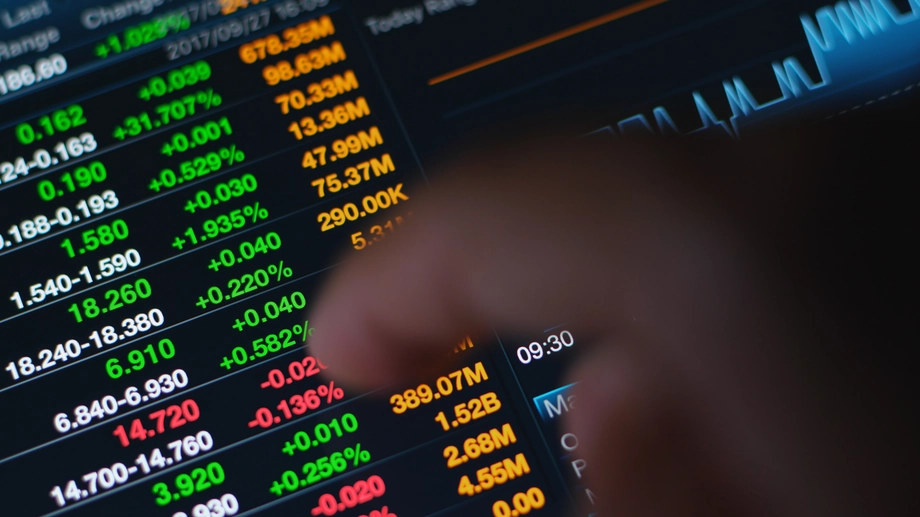
Table of Contents
In the tumultuous world of finance, two powerful forces dictate the course of markets: bears and bulls. Bear and bull markets are the heartbeat of the financial ecosystem, shaping the destinies of portfolios and the fates of investors. In times of a market downturn, or a bear market, undervalued sectors begin to identify themselves. Let’s explore how an investor, regardless of skill level, can navigate a turbulent market, and analyze which promising sectors could be labeled as “undervalued.”
A bear market refers to a financial condition in which stock prices are consistently declining, often by 20% or more from recent highs–not to be confused with a “market correction” which is typically characterized by a 10% or more decline from recent highs It signifies a pessimistic sentiment in the financial markets, with investors expecting economic downturns, high unemployment, and reduced corporate profits. During a bear market, fear and uncertainty drive many investors to sell their assets, causing further price drops. It can last for weeks or extend into months, impacting various asset classes such as stocks, real estate, and commodities. Bear markets are typically in contrast to bull markets, where asset prices are rising, and investor confidence is generally high.
Let’s breakdown the key differences between a bear and bull market:
Bear markets tend to be temporary downturns in an overall long-term growth trend. Having a diversified portfolio and long-term focus can help endure bear markets. Bull markets reflect positive sentiment but gains are not guaranteed. As always, thorough research is key before investing.
Step into the high-reward world of private equities. Don’t wait, your portfolio expansion starts here!
In short, no one can predict with certainty how markets will perform in future sessions. However, there are indicators that investors can monitor to better gauge a market’s current health and stability:
The duration of a market correction can vary significantly, and there is no fixed time frame for how long it takes for a market to correct itself. The length of a correction is influenced by several factors:
Some corrections are relatively short-lived, spanning only a few weeks or a couple of months, in response to temporary events or sentiment shifts.. Investors may view these as opportunities to buy discounted assets before an upward trend resumes.
On the other hand, some corrections driven by deep economic issues can last longer – several months or more. These require time for investor confidence to improve and problems to be resolved.
Approaching corrections with a long-term perspective is key. Consider your risk tolerance and goals when making decisions in response to market volatility. Predicting exact recovery time is difficult. t A thoughtful long-term investing strategy can provide stability during periods of volatility.
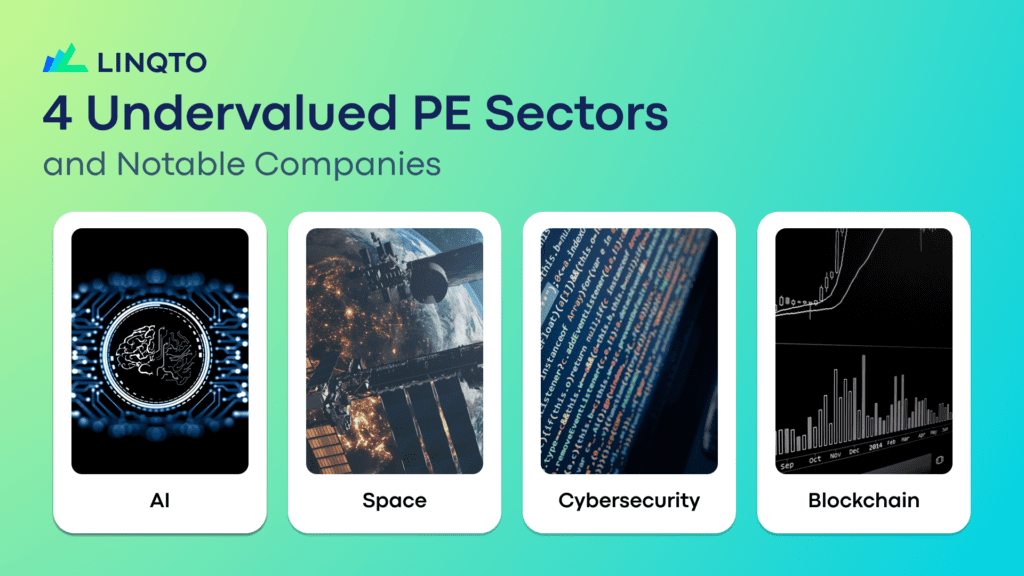
Artificial intelligence (AI) has become deeply ingrained in the global economy, permeating almost every facet of modern life. This technology is fundamentally altering how businesses operate through automation and data analysis. These AI tools are streamlining operations, optimizing supply chains, and improving overall efficiency, leading to cost savings and productivity gains.
In financial services, AI enables more accurate fraud detection, sophisticated trading algorithms , and data-driven risk assessment.. In healthcare, it is revolutionizing diagnosis, treatment, and drug discovery, while predictive analytics aids in managing healthcare resources more efficiently. Manufacturing leverages AI for intelligent robotics, quality control improvements, predictive maintenance, and next-gen automation. Retailers utilize AI to personalize customer experiences, optimize inventory management, and deliver efficient customer service through chatbots. Transportation is embracing AI for autonomous vehicles, traffic optimization, and safety,, while Energy relies on AI for electricity grid management, forecasting, and renewables.
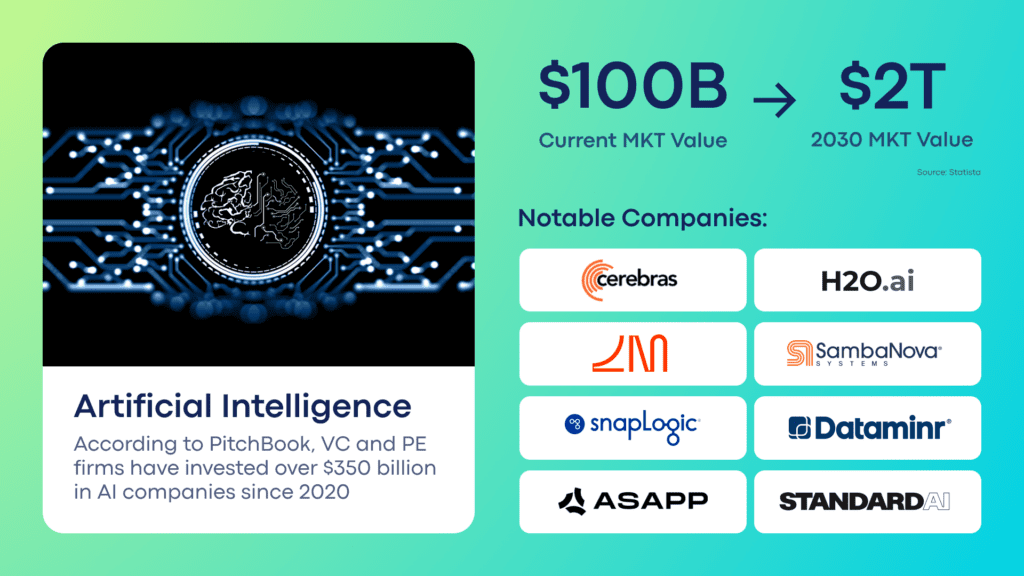
The applications of AI are far-reaching and still expanding. Statista values the current AI sector at over $100 billion, and expects that number to explode to $2 trillion by 2030 – a twentyfold increase underscoring the upside potential. And according to PitchBook, over $350 billion of fundraising and buyout deals has been conducted by institutional investors for artificial intelligence companies since 2020. With adoption proliferating across industries, AI’s contributions will compound, making it a pivotal economic technology.
Leverage the power of private equities. Make your move and accelerate your wealth creation journey today!
The cybersecurity sector has experienced unprecedented growth over the past few decades, evolving in response to the escalating cyber threat landscape, as the global economy increasingly revolves around the internet. With the proliferation of digital technologies, the demand for robust security measures has surged. Businesses, governments, and individuals alike have recognized the importance of safeguarding sensitive data and systems.
The growth throughout the cybersecurity industry has touched every subsector of the space. Cybersecurity firms have mushroomed, offering a diverse range of solutions, from firewalls to advanced threat detection systems. The workforce has expanded, with a surge in cybersecurity professionals, ethical hackers, and analysts. Investments in research and development have fueled innovation, resulting in cutting-edge technologies.
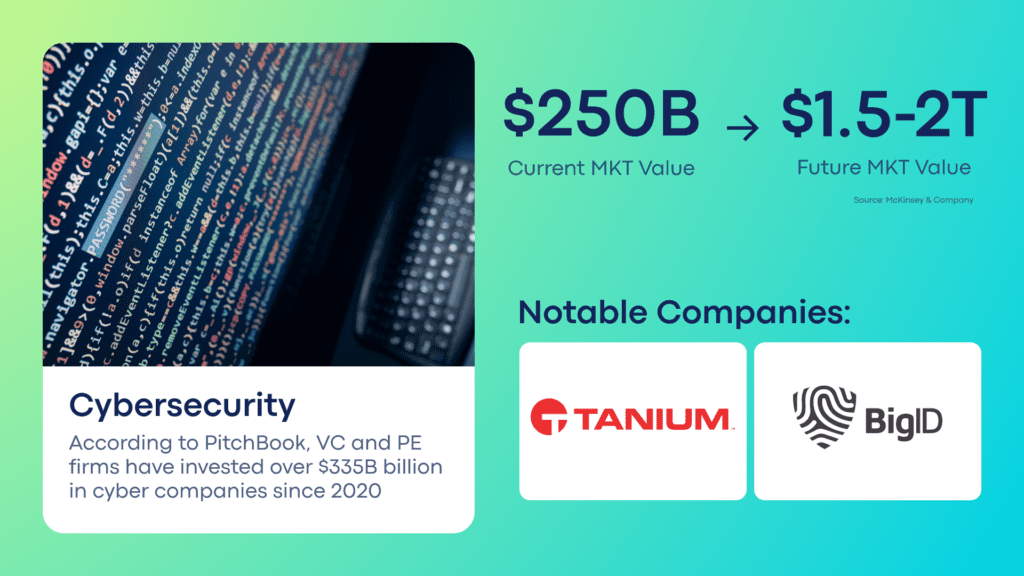
Analysts estimate the cybersecurity industry to currently be valued around $250 billion, but McKinsey and Company forecasts that the global cybersecurity addressable market could soon reach $1.5-$2 trillion, approximately ten times the size of the current vended market. This valuation could climb even higher in upcoming years, as damage from cyberattacks is expected to amount to about $10.5 trillion annually by 2025—a 300 percent increase from 2015 levels.
This immense growth potential is reflected in surging private investment. According to PitchBook, VC and PE firms have already poured over $335 billion into cybersecurity startups since 2020 through funding deals and acquisitions.
The space exploration sector is poised for significant growth in the coming years due to several key factors. First, the increasing involvement of private companies, such as SpaceX, Blue Origin, Virgin Galactic, and Axiom Space has injected innovation and competition, driving down launch costs and accelerating technology development. This has led to more frequent and cost-effective access to space. Second, the prospect of resource utilization and commercial opportunities in space has become increasingly attractive. Companies are eyeing asteroid mining, lunar habitats, and satellite constellations for communication and Earth observation, all of which offer potential for substantial profits.
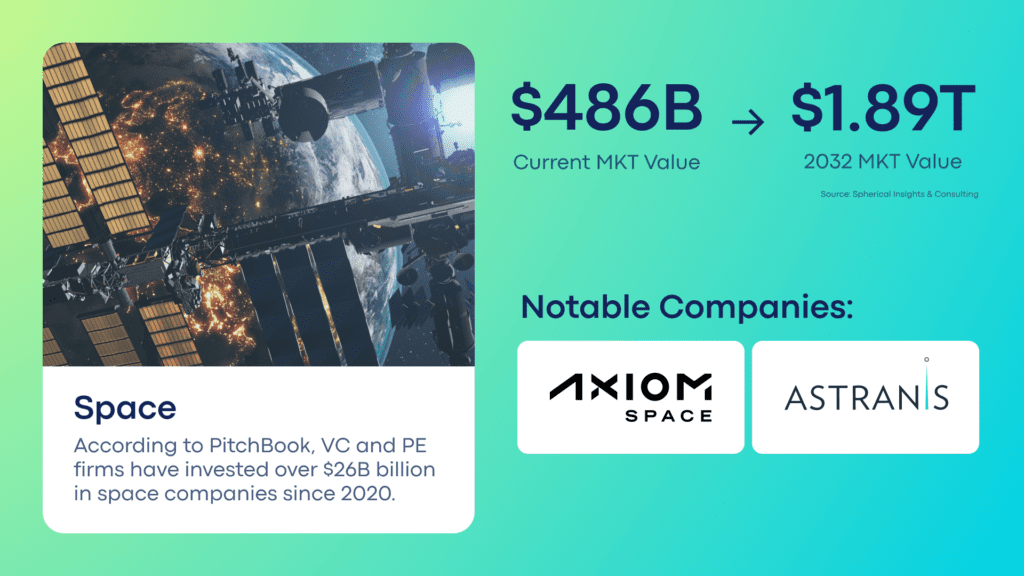
Moreover, international collaboration has expanded, with countries like China, India, and the United Arab Emirates making significant strides. These global partnerships foster unity and shared resources in space. Continued advancements in technology, including reusable rockets, artificial intelligence, and improved propulsion systems, are making missions more efficient and economical, further fueling growth.
Public interest and government support for space exploration are also on the rise, exemplified by NASA’s Artemis lunar program and the renewed focus on manned missions to the Moon and Mars.
The global space exploration market was valued at $486 billion in 2022 by Spherical Insights & Consulting, with the firm projecting the sector will be worth $1.89 trillion by 2032, highlighting the immense upside still ahead.
The blockchain technology sector is poised for explosive growth in the coming years due to several compelling factors. Blockchain’s intrinsic qualities, such as decentralization, transparency, and security, have made it increasingly attractive across various industries. This technology offers potential solutions to longstanding problems, including supply chain management, financial transactions, and data security.
With Bitcoin’s value rising nearly 30% over the past month, it’s becoming increasingly apparent that the nearly year-long detrimental phenomenon known as a “crypto winter” may finally be thawing.
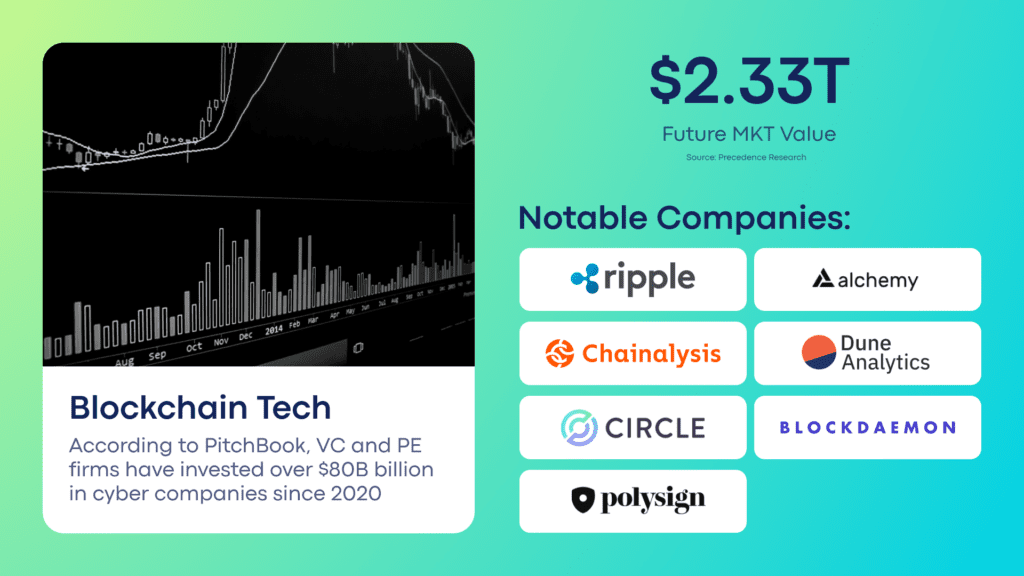
The adoption of blockchain by major corporations and financial institutions is on the rise. Many organizations are exploring blockchain applications, which can lead to streamlined operations, reduced costs, and increased efficiency. For instance, the finance industry is actively integrating blockchain for faster, more secure cross-border payments and smart contracts. Additionally, governments worldwide are recognizing blockchain’s potential for public services, including digital identity, voting, and land registries – providing new transparency and trust.
The global blockchain technology market size is estimated to reach a $2.33 trillion valuation by 2032, according to Precedence Research. This highlights the explosive growth still ahead as real-world blockchain adoption gains momentum across sectors.
As we conclude this analysis, it’s evident that staying ahead in the ever-evolving world of finance requires a discerning eye, a willingness to explore the uncharted, and a commitment to continuous learning. And while it’s extremely difficult to predict how markets may perform, investors can better prepare themselves by studying and keeping up to date on the indicators that have historically caused a market to dip or climb. We identified four sectors–AI, Cybersecurity, Space Exploration, and Blockchain Technology–as potentially “undervalued” because of their immense institutional backing and high ceiling in terms of expert-projected market values. We hope this blog and visual aids have been helpful in your investment journey, and we invite you to visit Linqto’s blog page for more educational resources.
This material, provided by Linqto, is for informational purposes only and is not intended as investment advice or any form of professional guidance. Before making any investment decision, especially in the dynamic field of private markets, it is recommended that you seek advice from professional advisors. The information contained herein does not imply endorsement of any third parties or investment opportunities mentioned. Our market views and investment insights are subject to change and may not always reflect the most current developments. No assumption should be made regarding the profitability of any securities, sectors, or markets discussed. Past performance is not indicative of future results, and investing in private markets involves unique risks, including the potential for loss. Historical and hypothetical performance figures are provided to illustrate possible market behaviors and should not be relied upon as predictions of future performance.